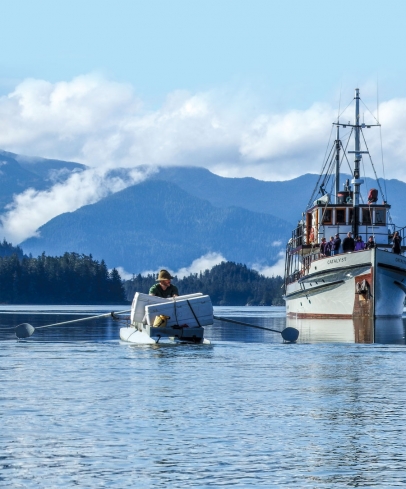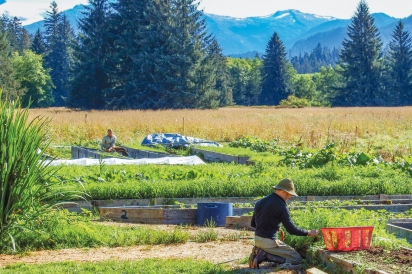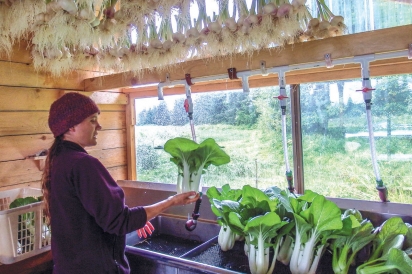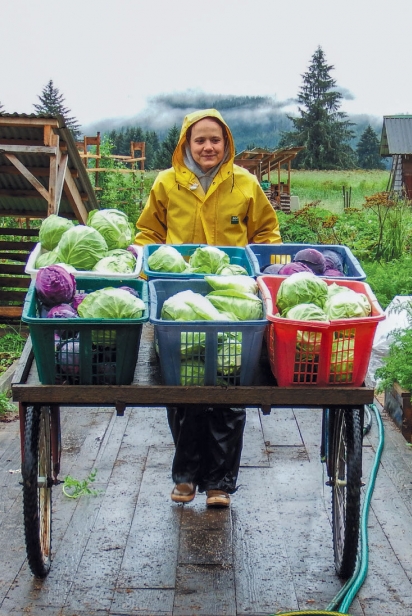Farragut Farm
Off the Grid and on to Plates
Jagged shorelines lined with alders, dense evergreen forests, and muddy tidal flats define the coastline of Southeast Alaska’s Inside Passage. Tuck into Farragut Bay, and you’ll find something else. About 35 miles by boat north of the town of Petersburg, up a windy slough, is a remote piece of land nurtured and cultivated to grow plants not typically found in the Southeast Alaska rainforest.
Farragut Farm is on an old river delta in the foreland of the expansive Stikine ice field. Here, meadows have risen up from tidal flats yet to be forested. There’s evidence of an old homestead, likely from the 1920s, but until recently there has been little or no agriculture. Over a number of years, Marja Smets and Bo Varsano have transitioned from a large home garden to a small but prolific vegetable farm. “We realized that we enjoyed being in Farragut Bay and growing food and it seemed like a nice challenge to combine that, stay here, and bump up to a farm,” says Marja.
It has taken Marja and Bo time and ingenuity to establish systems that overcome the landscape, remoteness, and weather in Farragut Bay. Today the farm produces over forty varieties of vegetables that are sold primarily in Petersburg. “Alaskans eat a lot of things that are harvested close to home, but for vegetables that is typically not the case. Everyone in Petersburg who goes to the store is eating vegetables that are barged in,” says Varsano.
Farragut Farm is providing an alternative for Petersburg residents: better quality, fresher, locally grown vegetables. “We do try to stick to things that grow well in our climate and don’t need a whole lot of extra coddling. We grow a few things that are given special attention, but they are in such demand that it is commercially viable,” explains Marja.
Producing vegetables commercially in Southeast Alaska is not a straightforward undertaking. “It has been interesting and tricky to figure out different ways of approaching growing vegetables on a commercial scale in this climate,” says Marja. The farm has four unheated greenhouses, one greenhouse that is heated with a woodstove, and numerous raised garden beds. Most of the greenhouses are moveable and slide on tracks to cover different portions of the farm throughout the season. By using moveable greenhouses, they are able to extend their season and increase vegetable production. “Anything that requires heat is going to benefit, and there’s so few naturally warm days in Southeast that it’s important to create a microclimate,” explains Varsano.
The limited arable land, pests, short growing season, and wet summers are among the factors that pose significant hurdles to many farmers. Marja and Bo are faced with yet another: Farragut Farm is completely off the grid. The remoteness of the farm adds some interesting complexity to the mix, and what’s more, they take extra care not to rely on fossil fuel intensive sources of energy. “The electricity, water, roads, an easy way to get from there to here, all the basic necessities of life we take care of for ourselves,” explains Marja.
Farragut Farm creates its own electricity with a small array of solar panels. Most of the farm work is completed by hand. “We are using some plastic and fuel, and a lot of things we can’t produce ourselves, but we are working to get away from that as much as we can, or at least minimize it,” says Bo. They use creative inventions and cleverly modified solar powered tools to maximize the efficiency of growing, harvesting, cleaning, and transporting vegetables.
The farm is continually looking at ways to increase efficiency. “We’re realizing more and more how important planning is for cutting down our labor.” An intricate system of planning multiple years in advance for crop rotation and the appropriate nutrients that specific vegetables will need is an example of the preparation and forethought necessary to keep things moving smoothly and efficiently. As soon as a vegetable is harvested for market another seedling is ready to plant in its spot.
Arguably even more arduous is planning their farm operations around the tides. Rather than a road for transport, Farragut Farm uses a slough that only fills with water on especially high tides to ferry materials and vegetables to and from the farm. “Once a vegetable is harvested, we need to wait until we have a high tide that is at least 15 to 15.5 feet high to have enough water to float the skiff. We then unload all of the vegetables onto the skiff and float them down our slough about half a mile to our sailboat. Then we transfer the coolers of vegetables from the skiff to our sailboat. Sometimes we have to do that in the middle of the night if that’s when there’s a high tide. Then, we sail or motor to town which generally takes four to five hours,” Marja explains.
Rain or shine, in rough seas and stormy Southeast Alaskan weather, Marja and Bo stay close to the elements as they move their produce from farm to market. Once in Petersburg, coolers are unloaded from the boat and onto a truck before being unloaded at the market to an eager crowd of lip-licking customers.
These farmers are constantly learning the best ways to operate in Southeast Alaska’s specific environmental conditions while improving efficiency to not waste time, energy, or space. “Every day we are thinking about how we can do this more effectively and efficiently to make this a more sustainable venture for us,” Marja explains.
In addition to focusing energies on their farm, Marja and Bo are actively working to empower other farmers and future farmers of the region to help them prosper “It has become a goal for us to help promote farming in the region, to do anything we can to move it along a little bit,” Varsano says. Last year Farragut Farm hosted the inaugural Southeast Alaska Commercial Growers Conference, which brought together agricultural producers from all stretches of the region. Marja added, “So many lessons have to be learned on your own terms and in your own time, but there’s a lot to be said for talking to someone who has already done something you are looking to pursue.”
Farragut Farm is working gracefully against the odds and it’s taken some true passion and creativity to sustain and grow this farm. “We feel like we’re contributing to our little corner of the world. Not only being able to grow high quality food that feeds the community, but we are taking care of our piece of land and hopefully making it a good place for lots of critters, plants, and animals into the future,” says Marja.
Ultimately it’s a fairly simple equation: good farming + good food = good for everybody.









